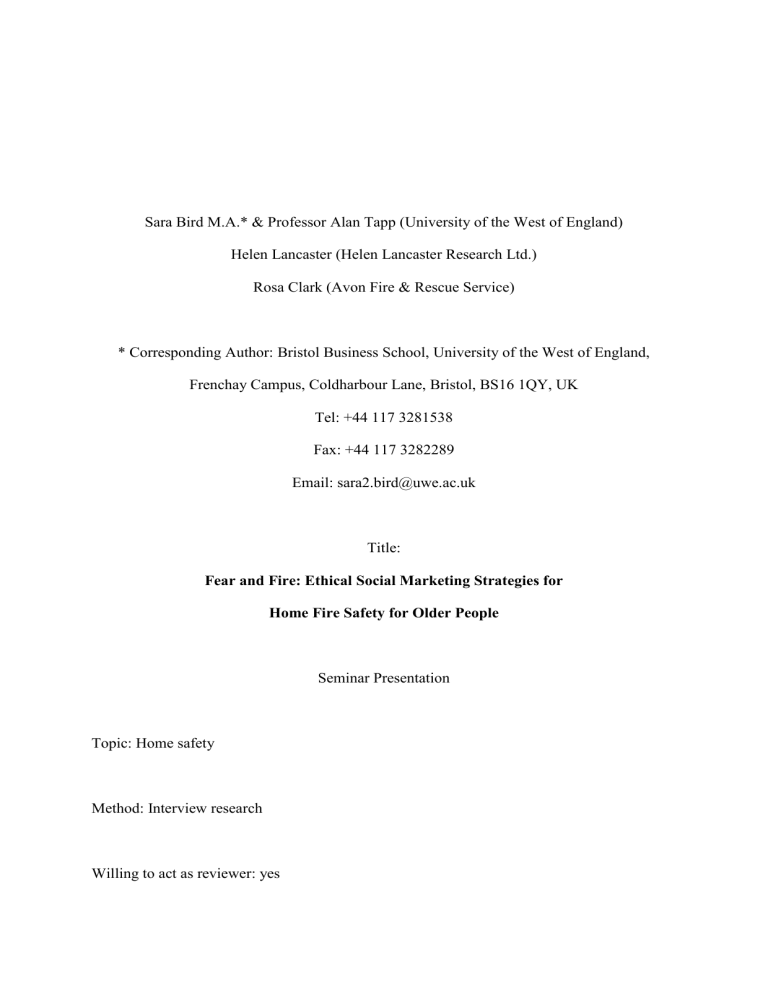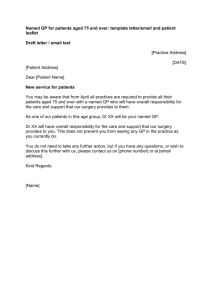Microsoft Word - UWE Research Repository

Sara Bird M.A.* & Professor Alan Tapp (University of the West of England)
Helen Lancaster (Helen Lancaster Research Ltd.)
Rosa Clark (Avon Fire & Rescue Service)
* Corresponding Author: Bristol Business School, University of the West of England,
Frenchay Campus, Coldharbour Lane, Bristol, BS16 1QY, UK
Tel: +44 117 3281538
Fax: +44 117 3282289
Email: sara2.bird@uwe.ac.uk
Title:
Topic: Home safety
Fear and Fire: Ethical Social Marketing Strategies for
Home Fire Safety for Older People
Seminar Presentation
Method: Interview research
Willing to act as reviewer: yes
Abstract
Avon Fire & Rescue Service use social marketing interventions to improve home fire safety amongst older people (aged 65+) in deprived areas of Bristol, UK, and this research seeks to identify the key triggers and barriers to behaviour change. Attitudes to fire and fire safety are explored, as are wider issues of the likelihood of behaviour change, and influential parties and media. We conclude that deprived older people present specific challenges to traditional social marketing strategies due to the diversity of the population and lack of research into effective segmentation. Deeply ingrained habits and routines resist behaviour change, with ethical implications for attempting to do so. The likely triggers to behaviour change are also deeply distressing, related to loss of life, pets, possessions or independence. This suggests that more subtle approaches are required using credible third parties such as daughters/sons, local news media and the Fire & Rescue Service themselves, requiring direct, one-off interventions that are more likely to be achievable than long-term sustained behaviour change.
Introduction
Older people from UK deprived communities are at high risk of injury/death related to domestic fire. They tend to live in older accommodation with furniture that does not meet fire regulations; they may be forgetful or have lost dexterity which contribute to starting fires; they may not detect fire and restricted mobility may prohibit escape. Avon Fire & Rescue
Service have an ongoing fire safety programme, but needed to know more about this group to maximise effectiveness of existing interventions and develop new social marketing strategies.
The key aim is to instigate Home Fire Safety Visits (HFSVs), where firefighters install 10year battery-operated smoke alarms, help occupants develop escape plans, and offer preventative advice on behaviours such as smoking, cooking or heating. Existing research from commercial marketing focuses on newly retired people with high disposable income - a lucrative target for private healthcare and leisure providers. Little is known about less
affluent older people, despite their relatively heavy reliance upon state healthcare and social support. This study seeks to establish motivations and barriers to behaviour change for older people in more deprived areas, and likely influencers and media, to develop social marketing strategies and policy implications for fire safety for providers such as Fire & Rescue Services.
Methodology
This study adopted a qualitative methodology, given the need for an exploratory approach regarding perceptions and meanings associated with fire, home safety and ageing. Participants aged 64-87 were recruited in local shopping centres and door-to-door in 3 high-risk areas of
Bristol, UK. Quota sampling was used to achieve representation of males/females, smokers/ non-smokers, users of alcohol, those living alone/couples and states of health/mobility. Semistructured ethnographic interviews were conducted in participants’ own homes, taking the interviewer through cooking, bedtime and other daily routines. Audio recordings of each interview were made, and transcribed into notes before drawing out key themes. We went on to interpret these in light of existing data and theoretical models.
Results
A total of 21 respondents (6 couples) were included in 15 face-to-face interviews in Bristol in spring 2010. A full sample composition according to gender, age, living status, smoking,
alcohol use, mobility, support and housing type is given in Table 1.
Diversity of Older People
Respondents demonstrated the diversity of older people aged 65+, highlighting the need for careful segmentation. Behavioural differences were aligned more closely with levels of affluence, mobility/health and living alone or as a couple, rather than geodemographic factors such as age or address e.g. the person in poorest health was aged 68 while a couple in their eighties were active members of the local community. This endorses the use of Moschis’
(1996a; 1996b) ‘Gerontographics’ model of segmentation (Figure 1), with most respondents
falling into the categories of ‘ailing outgoers’, ‘healthy hermits’ or ‘frail recluses’.
Habit and Routine
“I’ve always done it that way, don’t know why” Male, 80
An overriding theme was the role of habit and routine. Particularly for those living alone or less socially active, daily and weekly routines provide predictable, methodical means of accomplishing tasks. Disruption to routines causes confusion and even distress. The role of habit in behaviour change is much researched in transport (Verplanken et al. 2006), but this older group appear to be rely on habit more than other groups. This may be because habits are long established, or because they offer cognitive shortcuts for those with deteriorating memory and cognition. As Aarts et al. (1998) hypothesised, habit requires less mental effort and conscious decision making preceded by elaborate decision processes. This effectively sidesteps rational decision making models such as the Theory of Planned Behaviour (Ajzen,
1991). Social marketers should therefore endeavour to minimise disruption or ensure behaviour change becomes part of routines established soon after retirement.
Independence
“Shopping, my son goes one way, I go the other.
I do my own shopping, my son just takes me” Female, 87
For these respondents, sense of independence is paramount and closely tied to their own perceptions of whether they are ‘old’ i.e. dependent on others. Many were fiercely proud of their independence, even if further probing revealed that they may not be as independent as they contended. Few thought themselves old, though many considered others around them of comparable age to be ‘old’, implying messages directed at ‘old’ people will be screened out.
“A lot of old people –
I don’t feel old - who can’t get out. I feel sorry for them.
How will they get out? They’ll burn to death.” Female, 81
Attitudes to Fire and Fire Safety
Most respondents considered themselves unlikely to be at risk of fire. Using the Health Belief
Model (Hochbaum et al, 1952: Rosenstock, 1966; Rosenstock et al. 1988) (Figure 2) this is
attributable to low perceived susceptibility to fire: few thought there reason for a fire to start in their home unless it was something they had no control over, such as electrical faults.
Further probing, however, revealed many had experienced incidents such as small kitchen fires or cigarette burns, or that they knew people involved with significant domestic fires. A sense of denial around loss of cognition or dexterity, and ‘that would never happen to me, I’m too careful’ was detected, likely associated with denying old age and loss of independence.
“If the firemen found out how it started, I wouldn’t like to face them.
Endangering their lives because of something stupid I’ve done.”Female, 73
Key fears associated with fire were: loss of own life, loss of others’ lives, whether loved ones, neighbours, firefighters, or pets; loss of irreplaceable personal possessions e.g. photos of dead relatives; loss of home; loss of independence. Such thoughts were deeply distressing to respondents, and distanced themselves from these thoughts. The use of projective techniques
was valuable in eliciting deeper responses about this distressing topic (see Figure 3 and
“I would top myself rather than go to a home.”Male, 73
“It’s the feeling of losing something that has memories, things that have been with you.
Can’t replace your home, it’s not the same” Female, 81
Source Access and Credibility: Significant Others and Traditional Media
While respondents claimed to be highly independent, adult offspring had a strong role in implementing home safety measures. This was usually a local daughter, otherwise a son, or possibly friends or neighbours. This provides a useful route for social marketing strategies.
Looking at this through the concept of Locus of Control (Wallston et al., 1976) this group
seems highly influenced by powerful others including their own offspring (Figure 5).
“My youngest son tells me off…he said don’t you dare climb on those [steps] again…I wouldn’t defy him” (
Later
)“I do what I want. My sons give advice and I decide whether to follow it” (
Later
)“If something’s wrong or I’m worried... I’d always ask my son.”Female, 87
The Fire & Rescue Service was rated as a credible and influential source, with their direct mail/leaflets likely to be read and firefighters welcomed into their homes.
“I imagine if you have a fireman talking to you he stands out. He’s not like just you or me.
It might penetrate someone whose mind is beginning to go.” Female, 71
Local media rated highly as credible sources, with local television news being part of many daily routines. Radio did not feature highly and local newspapers were often difficult for older people to read due to poor eyesight. This has implications for other printed materials.
Implications for Practice and Policy
Given the distressing impact of the key triggers to fire safety concerns (loss of life, pets, possessions or independence) there are serious ethical implications for interventions emphasising these. Disrupting deeply ingrained routines would also have ethical implications related to distress. We advise less aggressive routes, gently implying that being unprotected may expose others (e.g. neighbours) to fire risks, and focussing on whole streets or blocks of flats rather than individuals. Images of family photos may convey much that words would make too upsetting. The current strategy of unannounced HFSVs is likely to be successful with this group as they are often at home and the Fire & Rescue Service is highly trusted.
Raising general awareness about fire safety would further lower barriers to this, and using local news media as a public relations route to endorse interventions would have high penetration and credibility with this group. Community networks, especially sons and daughters, are likely to be a successful means of using word-of-mouth and recommendation
to identify and target vulnerable individuals with HFSVs. In conclusion, in an area where persuasion can be distressing, direct interventions may be the more ethical alternative.
References
Ajzen, I. (1991). The theory of planned behaviour. Organizational Behavior and Human
Decision Processes. 50, 179-21
Hochbaum, et al. (1952), cited in Becker, M.H. (1974). The health belief model and personal health behavior. Health Education Monographs. 2 , 324-508.
Moschis, G. (1996a). Gerontographics . Quorum Books: Westport CT.
Moschis, G. (1996b). Life stages of the mature market.
American Demographics . September ,
44-50
Moschis, G.P., Lee, E. & Mathur, A. (1997). Targeting the mature market: opportunities and challenges. Journal of Consumer Marketing . 14 , 283-293
Rosenstock, L.M. (1966). Why people use health services, Millbank Memorial Fund
Quarterly . 44, 94-124
Rosenstock, L.M., Strecher, V.J. & Becker, M.H. (1988). Social learning theory and the health belief model. Health Education Quarterly. 15, 175-183
Verplanken, B., Aarts, H. , van Knippenberg, A. , & van Knippenberg, C. (2006). Attitude versus general habit: antecedents of travel mode choice. Journal of Applied Social
Psychology . 24 (4), 285 - 300
Table 1: Sample Composition
Total number
Hartcliffe & Withywood
Southville
Southmead
Female
Male
Living alone
Living with a housemate
Living as a couple
Aged 65-69
Aged 70-75
Aged 75-79
Aged 80-84
Aged 85+
Smoker
Drink occasionally
Drink heavily
Poor mobility
Moderate mobility
Good mobility
Formal support
Family/friend/neighbour support
No support
Council
Private
Interviews
15
5
5
5
2
6
7
10
5
Respondents
Figure 1: Gerontographics - Segmentation System for Older People
21
11
10
8
1
12 (= 6 couples)
3
5
5
7
1
7
13
2
5
6
10
Adverse health event
'Healthy indulgers'
'Ailing outgoers'
- concerned by health but positive selfesteem
- behave like younger consumers
'Healthy hermits'
- social withdrawal
Adverse life event e.g. death of spouse
Adverse life event e.g. death of spouse
'Frail recluses'
- biological and social ageing
Adverse health event
Adapted from Moschis, 1996a, 1996b
Figure 2: Health Belief Model
DEMOGRAPHIC AND
SOCIOPSYCHOLOGICAL
FACTORS
PERCEIVED
SUSCEPTIBILITY
PERCEIVED SERIOUSNESS
CUES TO ACTION
PERCEIVED BENEFITS
MINUS
PERCEIVED BARRIERS
PERCEIVED THREAT
Adapted from Hochbaum et al, 1952; Rosenstock, 196; Rosenstock et al. 1988
Figure 3: Speech Bubble Cartoon for Immediate Reactions to Fire
LIKELIHOOD OF TAKING
RECOMMENDED ACTION
Figure 4: Speech Bubble Cartoon for Long Term Reactions to Fire
Figure 5: Health Locus of Control
Internal locus of control
Chance
Possible position of locus of control for older deprived groups







